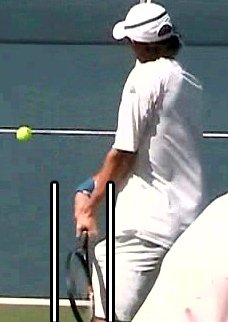Things get quite interesting in this next stage. What we see with Andy, which we really see with all great two handers, is some fascinating wrist action that allows a pulling of the racket forward into the slot.
So here is what is happening. First, like with the forehand, the tip of the racket points "outside". In the animation to the right, note how the tip of Murray's racket is pointing at the "J" in JP. As he starts to take his arms back, his wrists will fall backwards and downwards and then he will start to pull the butt cap forward through a mini "slot." This starts to bring the butt cap of the racket forward toward the ball at angle. This butt cap is now an axis of rotation around which the hands and racket can whip around, inside out, into contact.
Here the wrist of the right hand is just as interesting as the wrist on the left hand. In the picture below, you can see Andy's right wrist from three different angles. You can see how his right wrist is angled, or curved downwards. This wrist position not only allows him to "pull the racket through a slot", but it will let him rotate his wrists outward into the ball.

As the right wrist collapses downward, the left wrist will cock back and downward. Together these wrist positions allow you to pull the racket forward, butt cap first, "through a slot".

Here we can see what it looks like to be "in the slot" for the two handed backhand. Andy's right wrist is curved backwards. His left wrist is laid back. The racket is completely parallel to the side fence. Notice as well that his racket face is slightly closed.
Being "in the slot" is a key position for all ground strokes. It lets the racket come "inside out" into the ball in a burst of angular moment that generates tremendous racket speed coming into the ball.
In the next stage, the left arm will lift to contact while the hands rotate the racket inside out into the ball in a burst of racket head speed.
